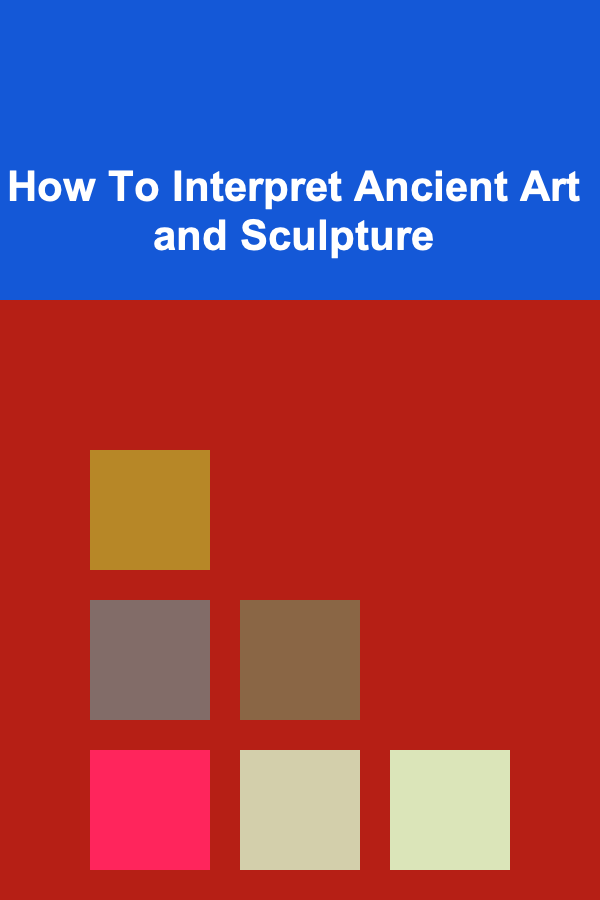
How To Interpret Ancient Art and Sculpture
ebook include PDF & Audio bundle (Micro Guide)
$12.99$5.99
Limited Time Offer! Order within the next:

Ancient art and sculpture are integral to understanding the cultures, values, and beliefs of societies long past. Whether it is the grand sculptures of Ancient Greece, the intricate reliefs of Ancient Egypt, or the symbolic pottery of pre-Columbian civilizations, each piece of art offers insight into the thoughts and practices of the people who created them. Interpreting ancient art and sculpture requires more than just a cursory glance; it involves decoding symbolism, understanding historical contexts, and considering the philosophical and cultural significance of the artwork. In this article, we will explore the methods and approaches used to interpret ancient art and sculpture.
Understanding the Historical Context
One of the first steps in interpreting any form of art, especially ancient works, is to understand the historical context in which the piece was created. Ancient art did not exist in a vacuum but was influenced by the cultural, political, and religious environment of its time. Each civilization's unique worldview, technological advancements, and social structure had a profound impact on the style and content of its art.
The Role of Art in Ancient Civilizations
In ancient societies, art was often created with specific purposes in mind. Art was used to communicate messages about the gods, nature, death, and the cosmos. It was also used as a tool for political propaganda, social control, and to commemorate important figures or events. For example, in Ancient Egypt, the creation of monumental sculptures and reliefs was often tied to religious and royal ideology, with pharaohs portrayed as god-like figures to reinforce their divine right to rule.
In Ancient Greece, on the other hand, art reflected the culture's values of beauty, reason, and humanism. Greek sculptures, particularly those of the Classical period, emphasized the idealization of the human form and explored themes of athleticism, heroism, and divinity. Understanding these purposes helps us interpret the meanings embedded within the works of art.
Political and Social Influence
The political and social conditions of a civilization also shaped its artistic output. For example, during the Roman Empire, the use of portraiture in sculpture was common to honor emperors and military leaders. These sculptures often emphasized power and authority, and were sometimes idealized to project strength and stability, even when the subject was less than physically perfect. The social structure of Ancient Rome, with its focus on hierarchy and status, also influenced how individuals were represented in art.
Decoding the Symbolism
Ancient art is often rich in symbolism. Artists would use specific motifs, colors, and arrangements to communicate messages that were understood by the people of the time. However, to modern viewers, these symbols may not always be immediately apparent. This is why scholars, archaeologists, and art historians dedicate significant time to studying the symbolic language of ancient art.
Iconography
Iconography is the study of the symbols and imagery within a piece of art. In ancient sculptures, certain poses, attributes, or objects held specific meanings. For instance, in Ancient Greek and Roman sculpture, the depiction of a hero or god with a particular weapon, like a spear or sword, would instantly signal their identity or role in mythology. In Ancient Egyptian art, the color and posture of a figure could convey their rank, importance, or divine status.
For example, in the famous reliefs of Ancient Egypt, pharaohs are often depicted in a larger-than-life scale, symbolizing their divine and unapproachable nature. The use of color also carried meaning---gold, for instance, was associated with the gods and immortality, while blue was associated with the heavens and the gods of the Nile.
Animals and Nature in Art
Animals, plants, and natural elements also held deep symbolic meaning in ancient art. The lion, for example, was a symbol of power and courage in many cultures, including Ancient Egypt, Mesopotamia, and Greece. The phoenix, often seen in Greek and Roman art, was a symbol of rebirth and immortality. Interpreting the role of animals and nature in ancient art requires knowledge of the mythology and belief systems that these symbols were rooted in.
In pre-Columbian art, for instance, animals often had spiritual significance. The jaguar was a symbol of power and transformation in the art of the Maya and Aztecs, while the serpent was associated with fertility and wisdom in various indigenous cultures of the Americas.
Understanding the Medium and Technique
The medium and technique used in ancient sculpture and art can also offer valuable clues for interpretation. Different materials---stone, clay, metal, and wood---had various symbolic and practical connotations. Stone, which was durable and often difficult to carve, was frequently used for religious or monumental art, while wood was more commonly used for everyday objects or smaller, less durable works.
Materials and Craftsmanship
The choice of material in sculpture could indicate the status of the subject or the importance of the work. In Ancient Egypt, for example, statues of pharaohs and gods were often carved from durable materials such as limestone, sandstone, or granite to emphasize their eternal nature. The fine craftsmanship displayed in these works also highlighted the skill of the artist and the resources available to the society.
In contrast, smaller sculptures in Ancient Greece might be made of marble, which was prized for its ability to capture fine details, or bronze, which allowed for greater fluidity and movement in the representation of the human body. Each material carried its own set of technical and aesthetic challenges, which in turn influenced the representation of the figures.
Techniques of Sculpture
Ancient sculptors employed various techniques to bring their subjects to life. In Greek sculpture, for example, the transition from the rigid forms of the Archaic period to the more naturalistic and dynamic figures of the Classical period represented a significant evolution in technique. Artists began to study anatomy and motion more closely, resulting in sculptures that conveyed a sense of realism and life-like movement.
In other cultures, like in Mesopotamia, sculptures were often created in low relief, with figures emerging from a flat surface. These reliefs were often used to tell stories, such as military victories or religious narratives, and were designed to be viewed from a specific angle.
The Role of Religion and Mythology
Religion and mythology have always played a central role in the creation and interpretation of ancient art and sculpture. Many ancient artworks were created for religious purposes, such as temples, shrines, and altars, and often depicted deities, heroes, and mythical creatures. Understanding the mythology and religious practices of the culture that produced the artwork is crucial to interpreting its meaning.
Deities and Divine Imagery
Ancient civilizations had a complex pantheon of gods and goddesses, each associated with different aspects of life, nature, and human experience. Sculptures of deities were often created to honor these gods, and they were believed to possess divine power. The poses, gestures, and attributes of gods in ancient art were laden with meaning. For example, the sitting position of Buddha in Indian sculpture symbolizes meditation and enlightenment, while the winged figures of angels in Christian art represent divine messengers.
In Ancient Egypt, the gods were frequently depicted in animal form, such as the jackal-headed Anubis, the falcon-headed Horus, and the cow-headed Hathor. These representations linked the gods to the natural world, highlighting their influence over life and death, as well as their omnipresence in the everyday lives of the people.
Myths and Stories in Sculpture
Many ancient sculptures tell stories from mythology. The Trojan War, the labors of Hercules, and the adventures of Gilgamesh all appear in various sculptures from the Greek, Roman, and Mesopotamian worlds. These mythological themes often reflected the values of the societies that produced them, such as heroism, wisdom, and the human struggle against fate.
In Ancient Greece, for instance, the depiction of mythological scenes in sculpture, like the battle between the Lapiths and the Centaurs, is filled with symbolic meaning. The struggle between order and chaos, represented by the Lapiths and Centaurs, was a reflection of the Greek values of civilization and reason.
Analyzing the Aesthetic Choices
While understanding the historical, symbolic, and religious contexts of ancient art is crucial, it is also important to consider the aesthetic choices made by the artist. The composition, proportions, and visual harmony in a work of art are not merely stylistic decisions; they reflect the values, philosophies, and technological capabilities of the time.
Proportions and Harmony
In Greek art, for example, the concept of proportion and harmony was paramount. The Classical Greek sculptors sought to create the idealized human form, which they believed represented beauty and virtue. This quest for ideal proportions culminated in the development of the "Canon of Proportions," a set of guidelines established by the sculptor Polykleitos to ensure balanced and harmonious figures.
Similarly, in Roman portraiture, the careful attention to detail and proportion was used to convey not just physical likeness, but the subject's character and moral virtues. Roman sculptors would often depict aging features in portraits of important figures to emphasize their wisdom and experience, while Greek portraiture was more focused on the idealization of youth and beauty.
Movement and Expression
Sculptors also made deliberate choices in how they conveyed movement and expression. In Greek art, the shift from the static figures of the Archaic period to the dynamic, lifelike figures of the Classical period marked a significant development in the understanding of human motion. The naturalistic portrayal of movement, such as the fluid stance of the Discobolus (Discus Thrower) by Myron, demonstrated a deep understanding of human anatomy and motion.
In contrast, Roman sculptures were often more focused on realism and capturing the individual characteristics of the subject. Portraits of Roman emperors, such as those of Augustus or Trajan, depict a sense of authority and resolve through their facial expressions and posture.
Conclusion
Interpreting ancient art and sculpture requires a multifaceted approach that combines historical knowledge, an understanding of symbolism, and an appreciation for the aesthetic choices of the artist. Through careful analysis of the materials, techniques, and cultural context, we can uncover the stories, values, and beliefs of the civilizations that created these works. Whether through the idealized forms of Greek sculpture, the divine representations of Egyptian art, or the realistic portraits of Roman emperors, ancient art offers a window into the past, allowing us to connect with the people and cultures that came before us.

Building Successful Brand Strategies in the Digital Age: A Guide for Digital Marketing Managers
Read More
How to Create a Home Gallery for Your Luxury Photography
Read More
How to Make a Checklist for Ensuring Your Website is Compatible with Screen Readers
Read More
How to Use an Online Household Budget Planner for Financial Success
Read More
The Art of Customer Experience: Leading Teams to Deliver Memorable Interactions
Read More
How to Identify Hidden Singles in Sudoku
Read MoreOther Products

Building Successful Brand Strategies in the Digital Age: A Guide for Digital Marketing Managers
Read More
How to Create a Home Gallery for Your Luxury Photography
Read More
How to Make a Checklist for Ensuring Your Website is Compatible with Screen Readers
Read More
How to Use an Online Household Budget Planner for Financial Success
Read More
The Art of Customer Experience: Leading Teams to Deliver Memorable Interactions
Read More